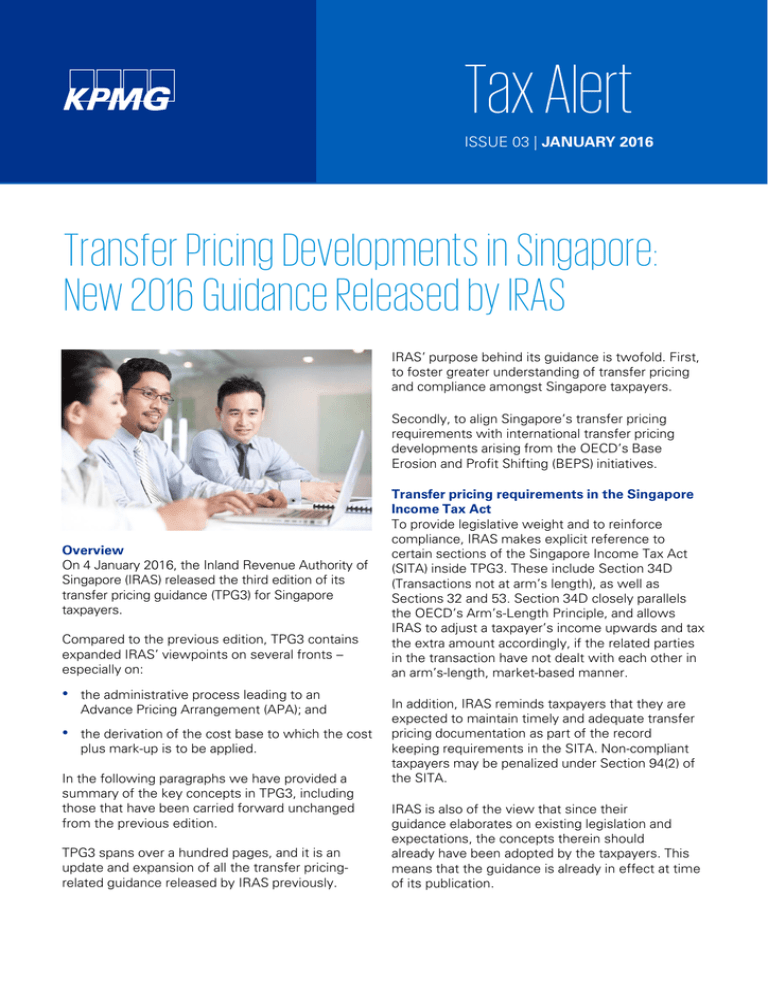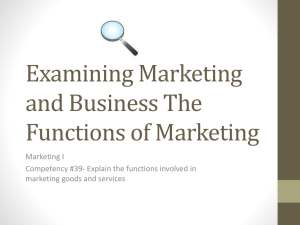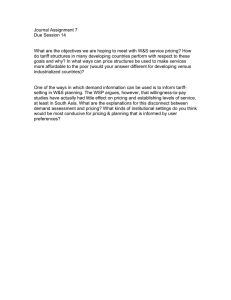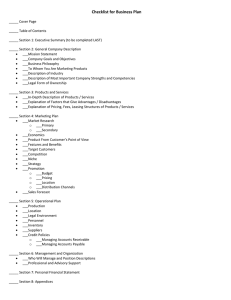
Tax Alert
ISSUE 03 | JANUARY 2016
Transfer Pricing Developments in Singapore:
New 2016 Guidance Released by IRAS
IRAS’ purpose behind its guidance is twofold. First,
to foster greater understanding of transfer pricing
and compliance amongst Singapore taxpayers.
Secondly, to align Singapore’s transfer pricing
requirements with international transfer pricing
developments arising from the OECD’s Base
Erosion and Profit Shifting (BEPS) initiatives.
Overview
On 4 January 2016, the Inland Revenue Authority of
Singapore (IRAS) released the third edition of its
transfer pricing guidance (TPG3) for Singapore
taxpayers.
Compared to the previous edition, TPG3 contains
expanded IRAS’ viewpoints on several fronts –
especially on:
•
the administrative process leading to an
Advance Pricing Arrangement (APA); and
•
the derivation of the cost base to which the cost
plus mark-up is to be applied.
In the following paragraphs we have provided a
summary of the key concepts in TPG3, including
those that have been carried forward unchanged
from the previous edition.
TPG3 spans over a hundred pages, and it is an
update and expansion of all the transfer pricingrelated guidance released by IRAS previously.
Transfer pricing requirements in the Singapore
Income Tax Act
To provide legislative weight and to reinforce
compliance, IRAS makes explicit reference to
certain sections of the Singapore Income Tax Act
(SITA) inside TPG3. These include Section 34D
(Transactions not at arm’s length), as well as
Sections 32 and 53. Section 34D closely parallels
the OECD’s Arm’s-Length Principle, and allows
IRAS to adjust a taxpayer’s income upwards and tax
the extra amount accordingly, if the related parties
in the transaction have not dealt with each other in
an arm’s-length, market-based manner.
In addition, IRAS reminds taxpayers that they are
expected to maintain timely and adequate transfer
pricing documentation as part of the record
keeping requirements in the SITA. Non-compliant
taxpayers may be penalized under Section 94(2) of
the SITA.
IRAS is also of the view that since their
guidance elaborates on existing legislation and
expectations, the concepts therein should
already have been adopted by the taxpayers. This
means that the guidance is already in effect at time
of its publication.
Transfer pricing documentation
Documentation requirements
IRAS requires transfer pricing documentation to be
maintained on a “contemporaneous” basis – that
is, the documentation should be in existence at the
time of undertaking the transactions. However,
IRAS will also accept documentation that has been
adequately completed by the tax filing due
date (in the year following the financial year end of
the taxpayer).
transactions where the risk of tax leakages is small,
there are certain exemptions from documentation.
Documentation content
TPG3 provides guidance on the information to be
included in transfer pricing documentation. This is
to be organised into group-level and entity-level
information.
Clarification of technical items
TPG3 contains detailed viewpoints on items such as
the use of multiple-year data for comparability
analyses, treatment of loss-making comparables,
and viewpoints regarding the use of local, private,
and public companies in the benchmarking process.
Group-level information is focused on items of
relevance to transactions with the Singapore
taxpayer. There is also an emphasis on describing
the value chain and contributions made by related
parties along the chain.
At the entity level, taxpayers are expected to
provide information specific to the Singapore
taxpayer’s operations.
Such information remains similar to that required
by IRAS previously, including:
•
details on the related-party transactions
including the parties involved and quantum of
transactions;
•
analysis of functions performed, risks
undertaken, and assets used by each party to
the transaction;
•
rationale for the chosen transfer pricing method
and tested party;
•
approach and details on comparability analyses
undertaken; and
•
derivation of an arm’s-length price range.
Where taxpayers have prepared relevant transfer
pricing documentation for compliance in other tax
jurisdictions, TPG3 indicates that such
documentation may form “part of” the
documentation for Singapore tax purposes. Hence,
while regional or global documentation can be a
starting point, it may be insufficient for full
compliance with Singapore requirements.
Exemptions from documentation
IRAS recognises that the requirements may be
onerous for taxpayers with smaller related-party
transactions. Hence, for these, as well as for
For example, product transactions below SG$15
million, services transactions below SG$1 million,
and either type of transactions between Singapore
parties with the same tax rate are exempt from
documentation. However, an exemption from
documentation does not equate to an exemption
from applying arm’s-length pricing.
Detailed insights on the use of various transfer
pricing methods and profit level indicators, under
different circumstances, are also provided. Of
particular note, specific conditions are also listed for
the use of the Berry Ratio. This may be of interest
for trading companies who have used the Berry
Ratio in testing their transfer prices.
Using safe harbours to set profitability
TPG3 reaffirms the existing cost plus five percent
safe harbour mark-up as a proxy for arm’s-length
compensation on intra-group services. This safe
harbour treatment applies only to defined routine
services, under certain conditions. While not in
TPG3, we note that IRAS is contemplating the
extension of the safe harbour concept to the interest
rate charged on intra-group loans.
Advance Pricing Arrangements
APAs are formal agreements between taxpayers and
authorities on the transfer pricing method and the
approach governing covered related-party
transactions. With an APA in place, taxpayers can
mitigate uncertainty and the risk of disputes over
transfer prices. Accordingly, APAs have grown in
popularity with a growing number filed by taxpayers
over the past few years. A substantive amount of
the changes found in TPG3 are focused on the APA
application process – with details on IRAS’
expectations over application timeline, covered
period, information to be submitted, etc.
Attribution of profits to permanent
establishment
TPG3 formalises IRAS’ viewpoint that no further
attribution of profits to a permanent establishment in
Singapore is likely when arm’s-length compensation
has been received. It also outlines the conditions
that are required to be met by taxpayers for the
above outcome.
Transfer pricing risk indicators
IRAS has reviewed taxpayers’ transfer pricing
compliance partly through the Transfer Pricing
Consultation (TPC) process. The process typically
starts with IRAS requesting information on relatedparty transactions through a questionnaire, and it is
likely to be followed by site visits and further
rounds of queries.
For companies assessing their transfer pricing
exposure, TPG3 provides insights on the risk
indicators IRAS uses to select taxpayers for TPC.
These include the value of related-party
transactions and business performance over time.
“Red flags” that IRAS considers to be indicative of
high transfer pricing risks include:
•
related-party transactions that are large relative
to other transactions;
•
recurring losses or large swings in operating
results not in line with the taxpayer’s functional
and risk profile; and/or
•
use of intangibles in the business.
In the course of the TPC, IRAS may arrange for a
site visit to understand more about the taxpayers’
transfer pricing policies. In almost all cases, transfer
pricing documentation will be requested by IRAS,
with submission to be made within 30 days of the
request.
IRAS has also indicated that it is monitoring
taxpayers’ compliance level and may consider more
stringent measures where necessary – including
the introduction of specific record-keeping
regulations for transfer pricing.
How companies are responding
With continual update of its transfer pricing
guidance, IRAS hopes to foster greater transfer
pricing compliance, not only through clarification of
its expectations, but also through reminders of its
audit programme and penalties for non-compliance.
A centrepiece of the IRAS compliance
requirements is adequate contemporaneous
transfer pricing documentation.
Flowing from this, a substantial number of
companies have embarked on projects to update or
prepare their transfer pricing documentation. It is
important for this document to be in place to
mitigate transfer pricing exposure.
How KPMG can help
At KPMG, we have assisted many companies
in addressing transfer pricing issues by:
•
recommending appropriate arm’s-length
transfer prices to value transactions for both
documentation and planning purposes;
•
defending against tax authorities’ audits of
transfer prices;
Adverse implications of non-compliance
TPG3 explicitly mentions several adverse
implications for taxpayers that do not comply with
the documentation requirements or the arm’slength principle.
•
preparing contemporaneous
documentation;
•
negotiating APAs with tax authorities to
cover future transfer prices;
Specifically, IRAS has the legislative power under
Section 34D of the SITA to impose upward
adjustments to the taxpayer’s taxable profits. There
may also be penalties for under-declaration of
income tax. In addition, where transfer pricing
documentation is not available, IRAS may not
support the taxpayer in a Mutual Agreement
Procedure to resolve double taxation, or may not
accept the taxpayer’s APA application.
•
making presentations on behalf of
taxpayers during IRAS’ Transfer Pricing
Consultation process; and
•
assisting in the identification and
quantification of transfer pricing positions
for mergers and acquisitions, FIN48, and
corporate financial control purposes.
Contact us
Tay Hong Beng
Head of Tax
T: +65 6213 2565
E: hongbengtay@kpmg.com.sg
Geoffrey Soh
Head of Transfer Pricing
T: +65 6213 3035
E: geoffreysoh@kpmg.com.sg
Felicia Chia
Director, Transfer Pricing
T: +65 6213 2525
E: fchia@kpmg.com.sg
KPMG
16 Raffles Quay
#22-00 Hong Leong Building
Singapore 048581
T: +65 6213 3388
F: +65 6227 1297
Find out more about our services at kpmg.com.sg
Tier 1 Firm for Tax Advisory (2016), Transfer Pricing and
Tax Transactional (2015) – International Tax Review.
For more details of our Tax services, please click here.
About Tax Alert
KPMG’s Tax Alerts highlight the latest tax
developments, impending change to laws or
regulations, current practices and potential
problem areas that may impact your company. As
certain issues discussed herein are time sensitive
it is advisable to make plans accordingly.
“Tax Alert” is issued exclusively for the
information of clients and staff of KPMG Services
Pte. Ltd. and should not be used or relied upon as
a substitute for detailed advice or a basis for
formulating business decisions.
kpmg.com/socialmaedia
kpmg.com/app
The information contained herein is of a general nature and is not intended to address the
circumstances of any particular individual or entity. Although we endeavour to provide
accurate and timely information, there can be no guarantee that such information is
accurate as of the date it is received or that it will continue to be accurate in the future.
No one should act on such information without appropriate professional advice after a
thorough examination of the particular situation.
© 2016 KPMG Services Pte. Ltd. (Registration No: 200003956G), a Singapore
incorporated company and a member firm of the KPMG network of independent member
firms affiliated with KPMG International Cooperative ("KPMG International"), a Swiss
entity. All rights reserved. Printed in Singapore.




